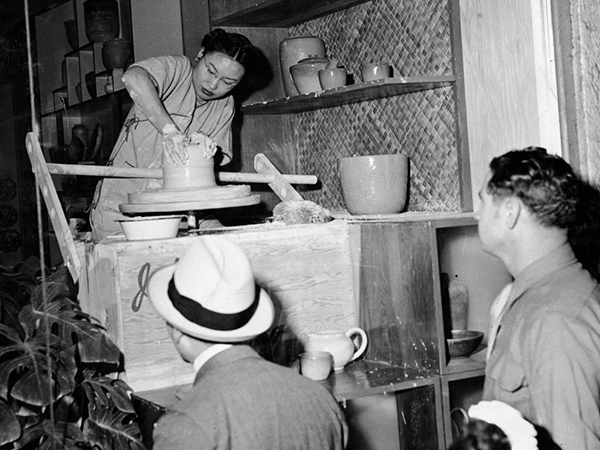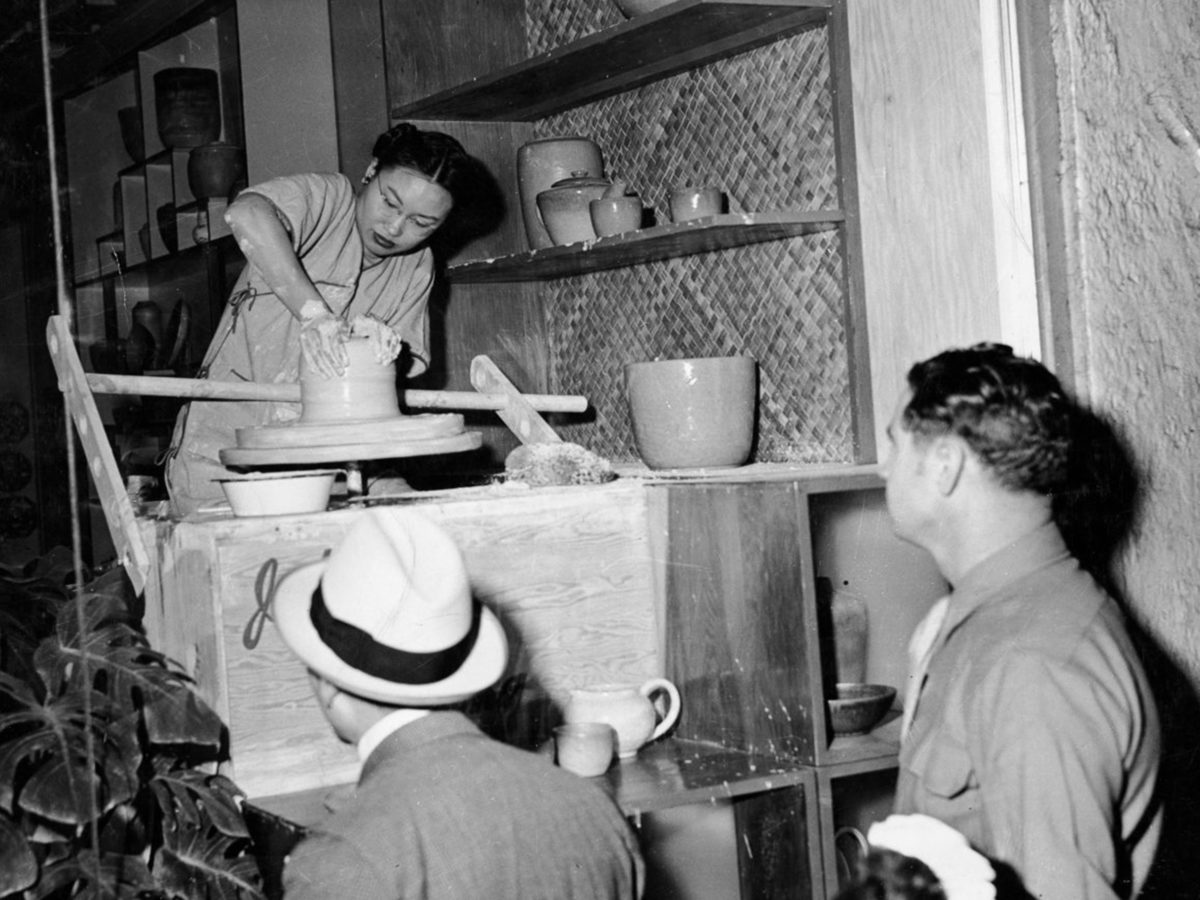Activity
The Art and Science of Jade Snow Wong’s Work
Lesson: Students will 1) learn some of the hallmarks of Wong’s ceramics and enamels; 2) gain a general understanding of the ceramics- and enamel-making processes; and 3) understand some of the scientific processes involved in art.

Jade Snow Wong
Common Core Standards
Visual Arts 1.0: Processing, Analyzing, and Responding to Sensory Information Through the Language and Skills Unique to the Visual Arts
Visual Arts 3.0: Understanding the Historical Contributions and Cultural Dimensions of the Visual Arts
Visual Arts 4.0: Responding to, Analyzing, and Making Judgments about Works in the Visual Arts
Visual Arts 5.0: Connecting and Applying What is Learned in the Visual Arts to Other Art Forms and Subject Area and to Careers
K-12.SL.1: Engage effectively in a range of collaborative discussions (one-on-one, in groups, and teacher-led) with diverse partners on grade appropriate topics and texts, building on others’ ideas and expressing their own clearly and persuasively.
2-PS1-1: Plan and conduct an investigation to describe and classify different kinds of materials by their observable properties.
Activity
Watch and discuss videos of Mark Ong (Jade Snow Wong’s son) (below) explaining his mother’s methods in the studio as well as the considerations that went into creating her pieces.
Some useful vocabulary:
Ceramic: art piece made of clay that has been fired in a kiln
Glaze: a glassy coating that helps to make a ceramic waterproof
Flux: a substance that helps a glaze to melt and fuse
Slip: a mixture of clay and water that is used for decorating ceramics
Enameling: the use of heat to fuse powdered glass onto a surface, usually metal
Follow-Up Discussion Questions
- According to her son and to the excerpts from her books, what were the defining traits of Jade Snow Wong’s art? (What did she emphasize/pay close attention to in her pieces?)
- What are some of the things that could go wrong while Wong was working in the studio? Given the possible setbacks that could occur, what life lessons did Wong have to accept to keep doing her art?
An Interdisciplinary Project
In the ceramics video, Ong describes his mother’s efforts to mix new glazes, work that required extensive experimentation and careful recording of data. In many respects, she was just as much a scientist as an artist. Students could do some research or “detective work” on the science involved in ceramics. A possible prompt for this project is the following passage from Wong’s second memoir, “No Chinese Stranger”:
“Creativeness was 90 percent hard work and 10 percent inspiration. It was learning from errors, either from her lack of foresight or because of the errors of others. The first firing in an unfamiliar new gas kiln brought crushing disappointment when the wares blew up into tiny pieces. In another firing, glaze results were uneven black and dark green, for the chemical supply house had mistakenly labeled five pounds of black copper oxide as black iron oxide. One morning there was a personal catastrophe. Unaware of a slow gas leak all night from the partially opened gas cock, she lit a match at the kiln. An explosion injured both hands, which took weeks to heal.” (23)
To get the students started, you could ask them to use a highlighter to mark the parts of this quotesthat are “mysteries” to them. What are they wondering about? Ask them to write down the questions they want to answer in order to understand this passage fully.
As part of their investigation, the students could do internet and library research as well as interview the science and art teachers at their school. The “detectives” could then share their findings with the class; they would thus help their peers to understand just how painstaking (and sometimes dangerous) Wong’s work could be.
If you have time, you could have the detectives do safe, simple demos that could help explain the scientific processes involved in Wong’s art. For example:
- Showing how/why copper pennies turn green/black.
- Creating a “mystery solution” out of food coloring and having students experiment to find just the right mix of food colorings to reproduce the mystery color (to show the experimentation and careful notation needed to create certain glazes).
- Watching popcorn pop in the microwave to understand why ceramics might explode in the kiln (the build-up of steam inside a kernel leads it to “pop,” just as a ceramic bowl might explode from too much moisture in the air pockets in the clay).
High school chemistry students could go further and investigate the various elements and processes that produce glazes.
The Spruce Crafts website provides resources on:
- the making of glazes :https://www.thesprucecrafts.com/what-goes-into-glazes-2746232
- the factors involved in creating certain glaze colors: https://www.thesprucecrafts.com/ceramic-and-glaze-colorants-2745859
- oxidation and reduction in the firing process: https://www.thesprucecrafts.com/oxidation-and-reduction-atmospheres-2745940
Here is a more detailed explanation of the chemical reaction involved in reduction:
https://ceramicartsnetwork.org/daily/firing-techniques/gas-kiln-firing/demystifying-the-reduction-firing-process/
With the help of their chemistry teacher, students can choose their favorite Jade Snow Wong ceramic and try to figure out the ingredients for the colors in the piece and even write out the oxidation or reduction equations for producing those colors.
Additional Resources for More STEM-Related Lessons:
For further discussion of the chemistry of pottery — including the plasticity of clay, the difference between earthenware and stoneware, and the creation of glazes and colors — see the Royal Society of Chemistry’s “Education in Chemistry” website:
https://eic.rsc.org/feature/the-chemistry-of-pottery/2020245.article
For further discussion of the chemistry and physics of enameling, see the following page from the Ganoskin website:
https://www.ganoksin.com/article/origins-evolution-practice-enameling/
The process of sifting enamel evenly onto a cup or a bowl entails some knowledge of geometry and physics; a discussion of this process can be found here:
https://www.ganoksin.com/article/proper-enamel-sifting-process/
Just as Wong had to keep safety in mind when firing ceramics in a kiln, she also dealt with safety concerns while enameling; here is a clear explanation of the issues involved (including the issues caused by certain chemicals):
https://www.ganoksin.com/article/enameling-safety-issues-know/
For more lessons based on Jade Snow Wong, visit the artist’s teacher packet.





